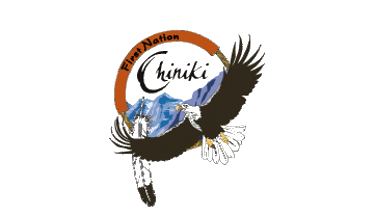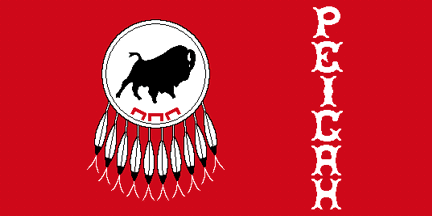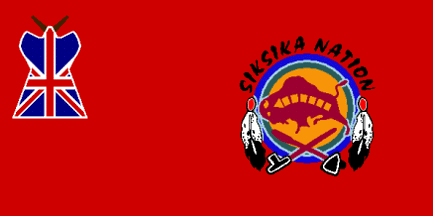Treaty Seven
The Flag of Treaty Seven
The Treaty 7 flag serves as a powerful emblem representing the unity, heritage, and ongoing significance of the First Nations that are signatories to Treaty 7. Signed on September 22, 1877, at Blackfoot Crossing in present-day Alberta, Treaty 7 was an agreement between the Crown and several Indigenous nations, including the Siksika (Blackfoot), Kainai (Blood), Piikani (Peigan), Stoney-Nakoda, and Tsuut’ina (Sarcee) peoples.
The flag itself is characterized by a white field featuring the Treaty 7 logo prominently at its center. The logo, designed by the late Tony William Hunt Sr., a renowned Kwagiulth artist, encapsulates the essence of the treaty and the unity of the participating nations.
The design elements of the logo are rich in symbolism. Central to the logo is a circle, a shape deeply significant in Indigenous cultures, representing unity, wholeness, and the cyclical nature of life. Within this circle, there are representations of the various First Nations involved in the treaty, each depicted with symbols pertinent to their cultural identities and traditional territories. The use of traditional motifs and imagery serves to honor the heritage and histories of these nations, while the encompassing circle underscores their collective unity under Treaty 7.
The white background of the flag symbolizes peace and the solemn nature of the treaty agreement. It reflects the intentions of both the Indigenous nations and the Crown to establish a harmonious relationship and coexistence.
Map of the Numbered Treaties
The Treaty 7 flag holds a place of honor in various institutions and events within the Treaty 7 territory. For instance, on March 23, 2017, the City of Calgary raised the Treaty 7 flag at City Hall, recognizing the city's location within the traditional lands of the Treaty 7 nations. This act was a significant step in acknowledging the enduring presence and contributions of Indigenous peoples in the region.
Similarly, educational institutions such as Mount Royal University have permanently raised the Treaty 7 flag alongside the Métis flag to honor and recognize Indigenous histories and cultures. These actions are part of broader efforts towards reconciliation and fostering a deeper understanding of Indigenous heritage among the wider community.
The flag is also prominently displayed during cultural events, such as powwows and rodeos, serving as a visual reminder of the enduring significance of Treaty 7 and the unity of the First Nations involved. Its presence at these events reinforces the cultural pride and resilience of the Indigenous communities.
Communities in Treaty Seven
Communities Without a Flag
Blood Tribe First Nation
Recently Posted
Categories
- Alberta 11
- Armed Forces 16
- British Columbia 6
- Canada 130
- Cities 64
- County / Municipality / Regional District / Township 1
- Government 9
- Historical 2
- Indigenous 17
- International Flags 26
- International Organizations 3
- Manitoba 4
- New Brunswick 3
- Newfoundland 7
- Northwest Territories 4
- Nova Scotia 6
- Nunavut 5
- Ontario 8
- Police 1
- Prince Edward Island 4
- Quebec 20
- Royalty 6
- Saskatchewan 7
- Schools 1
- Sports 4
- Yukon 2










